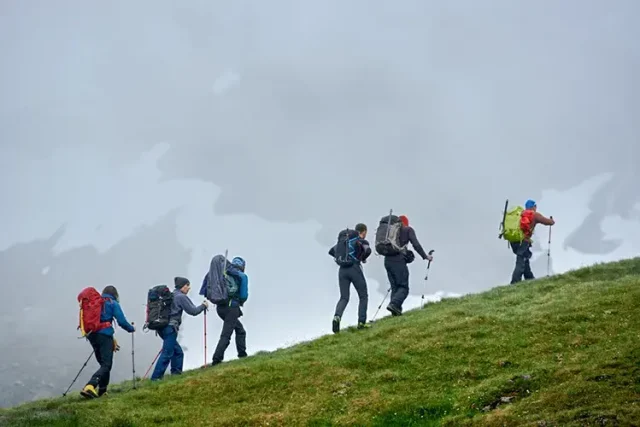
When preparing for a hiking trip, what you wear can significantly affect your comfort, safety, and overall experience. Proper clothing and gear help regulate your body temperature, protect against the elements, and ensure mobility on rugged terrain. Whether you plan to hike in summer heat or brisk autumn air, understanding how to layer and select the right equipment is essential for a successful adventure.
From moisture-wicking base layers to durable outer shells, this guide covers all the essentials for dressing appropriately across all seasons. It also highlights key accessories like hats, gloves, and sunglasses to keep you protected and comfortable on the trail. With the right preparations, you can focus on enjoying nature without worrying about weather or discomfort.
How Does a Base Layer Impact Your Hiking Experience?
The base layer is your first line of defense against moisture and temperature fluctuations. Its primary purpose is to wick sweat away from the skin to keep you dry and prevent chills caused by dampness. Materials like merino wool and synthetic fibers such as polyester excel in this role.
Merino wool is especially popular for its natural temperature regulation and odor resistance, making it suitable for both warm and cold conditions. Synthetic fabrics dry quickly and often cost less, making them practical for shorter trips or warmer climates. Choosing a lightweight base layer that fits snugly but allows freedom of movement will improve your comfort significantly.
What Are the Benefits of Mid Layers in Temperature Regulation?
Mid layers provide insulation by trapping warm air close to your body while allowing moisture to escape. This balance helps maintain a comfortable core temperature during periods of rest or cooler weather.
Common mid-layer options include fleece jackets, lightweight down vests, and synthetic insulated pullovers. Fleece is breathable and dries rapidly, making it a favorite among hikers. Down insulation offers excellent warmth but performs best when kept dry. Synthetic insulated layers maintain warmth even if wet, ideal for damp environments.
Selecting a versatile mid layer that can be easily added or removed allows you to adapt quickly to changing weather or activity levels on the trail.
Why Is Choosing the Right Outer Layer Crucial for Protection?
The outer layer protects you from wind, rain, and snow while allowing excess heat and moisture to escape. A high-quality shell jacket should combine waterproofing, breathability, and durability.
Look for jackets with waterproof membranes such as Gore-Tex or proprietary technologies that prevent water from penetrating while minimizing internal condensation. Ventilation options like pit zips or adjustable cuffs help regulate airflow. Durable fabrics protect against abrasions from branches or rough terrain.
A dependable outer layer will shield you from the elements, keeping you dry and comfortable throughout your hike.
How to Select Hiking Pants and Shorts for Comfort and Mobility?
Choosing the right bottoms is just as important as your upper layers. Lightweight, quick-drying hiking pants made of nylon or polyester blends offer breathability and flexibility. Convertible pants with zip-off legs provide versatility, allowing you to switch between pants and shorts as conditions change.
For colder weather, insulated pants or layering with thermal leggings will add warmth without restricting movement. Shorts are suitable for hot, dry climates or vigorous activity but consider durable fabrics that resist tearing.
Prioritize comfort, range of motion, and weather-appropriate materials when selecting pants or shorts for your trip.
What Footwear Should You Consider for Different Trails?
Footwear choice depends on terrain, weather, and personal preference. Hiking boots provide ankle support and stability on rocky or uneven surfaces. Look for waterproof models if you expect wet conditions.
Trail running shoes offer lightweight flexibility and faster movement but may sacrifice some protection and support. For well-maintained, flat trails, hiking shoes or sturdy sneakers might suffice.
Ensure your footwear has adequate grip, fits well, and matches your hiking environment to prevent blisters or injuries.
How Do Hats and Gloves Enhance Your Outdoor Experience?
Protecting extremities is vital for both comfort and safety. Hats shield your face and neck from sun exposure, reducing the risk of burns and heat-related issues. Wide-brimmed hats or caps with UV protection are effective choices.
Gloves keep hands warm in chilly weather and provide protection against rough vegetation or rocky surfaces. Materials range from lightweight synthetic gloves for mild conditions to insulated, waterproof options for cold weather.
Selecting appropriate head and handwear adds an extra layer of comfort during varying weather conditions.
What Layering Strategies Work Best in Cold Weather?
Cold weather demands careful layering to maintain warmth without overheating. Start with a moisture-wicking base layer, add an insulating mid layer, and finish with a protective outer shell.
Adjusting layers based on activity level is crucial. Remove mid or outer layers during strenuous uphill climbs to prevent sweating. Add layers during rest periods or when facing wind and cold.
Proper layering allows you to regulate body temperature efficiently and reduces the risk of hypothermia or chills.
How Can You Protect Yourself from the Sun While Hiking?
Sun protection is essential regardless of season. Clothing with built-in ultraviolet (UV) protection shields your skin from harmful rays. Long sleeves, neck gaiters, and sunglasses are key components.
Quality sunglasses not only reduce glare but also filter UV rays, helping to protect your eyes from potential damage. Opting for well-designed sunglasses can enhance comfort and durability, especially when engaging in outdoor activities like hiking.
Using sunscreen on exposed skin and choosing hats with brims further safeguard against sunburn and long-term skin damage.
What Are the Essentials for Rainy Weather?
Rain can quickly turn a pleasant hike into an uncomfortable ordeal. Waterproof jackets and pants crafted from breathable fabrics keep moisture out while allowing sweat to escape.
Pack rain covers for your backpack to protect your gear. Opt for quick-drying clothing underneath rain gear to avoid prolonged dampness.
Choosing rain-specific gear ensures you remain dry and maintain body heat, even during unexpected downpours.
What Additional Accessories Should You Consider for Your Hiking Trip?
Beyond clothing, several accessories enhance comfort and convenience on the trail:
- Gaiters protect your lower legs and boots from dirt, water, and debris.
- Hydration packs or water bottles keep you well-hydrated on long treks.
- Trekking poles provide stability and reduce strain on joints.
Lightweight insect repellents and headlamps are also useful additions for extended or evening hikes.
To sum up, selecting appropriate clothing and accessories for hiking is key to maximizing comfort and safety. By understanding the purpose of each layer and choosing gear tailored to your environment and activity level, you can confidently face the challenges of any trail.
With thoughtful packing and smart clothing choices, your next hiking trip will be not only successful but truly enjoyable.





